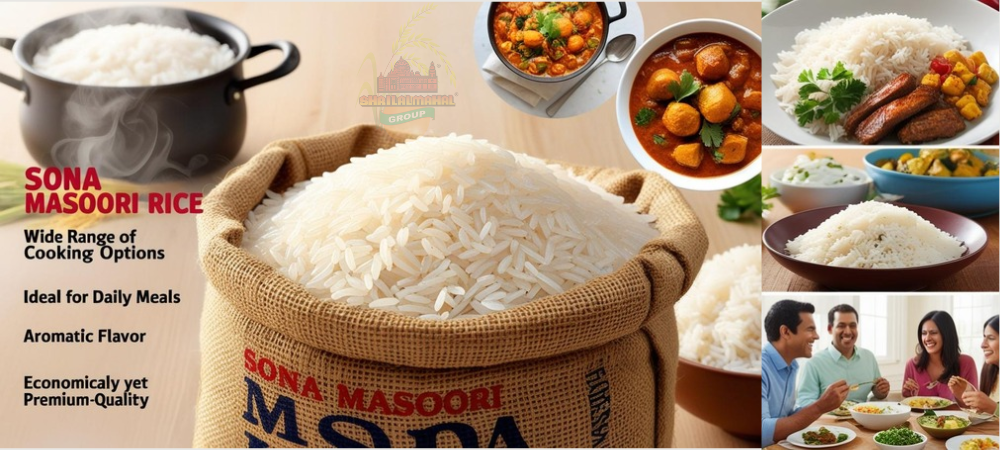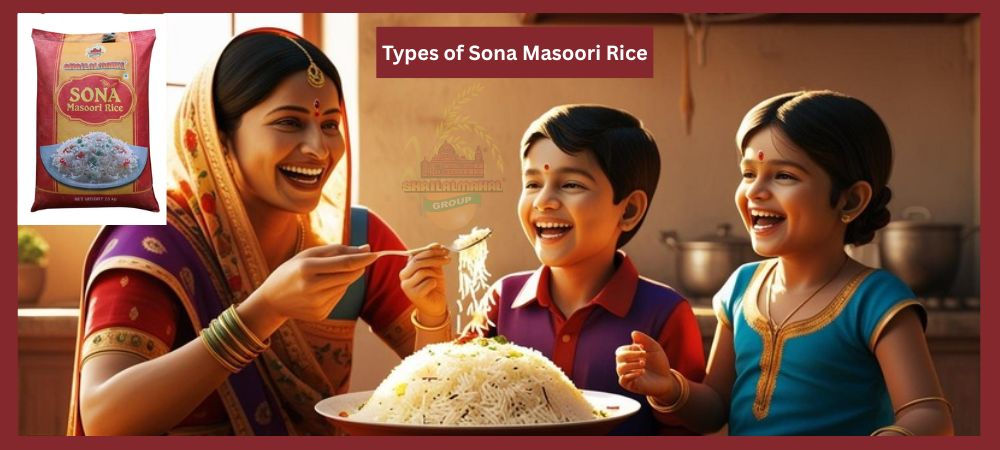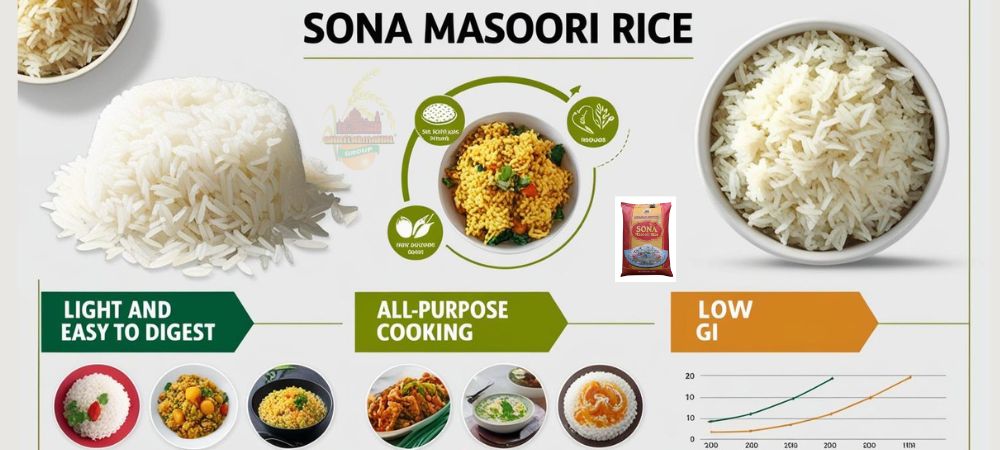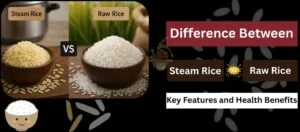Sona Masoori Rice is a premium quality rice grown mainly in the Indian states of Andhra Pradesh and Telangana. It has gradually gained immense popularity owing to its aromatic fragrance, health benefits that includes low starch and light in weight, and delicious food items that can be prepared using this premium quality of rice.
Sona Masoori Raw Rice is commonly used to prepare sweet Pongal, Biryani, Idli, and Fried Rice. This blog by Shri Lal Mahal will help you determine the benefits, price, and other qualities of this special variety of rice. This special quality of rice is a cross between two rice varieties, Sona and Masoori. Though, both Sona and Masoori are two varieties of rice famous in India, but Sona Masoori is a perfect blend of both and is a light, fluffy, aromatic, and high in nutrients, boasting a rich fiber bran coating which is more nutritious and healthier than the one which comes with a white layer.
What is Sona Masoori Rice?
Sona Masoori is a type of medium-grain rice that comes under the common crop in the southern parts of India. Major cultivation of Sona Masoori rice takes place in Andhra Pradesh, Telangana, and Karnataka. Lighter in weight, it becomes a good choice for ordinary consumption. Sona Masoori rice is short, less fragrant, and softer as compared to the long, fragrant Basmati rice. It is used quite regularly in many South Indian food preparations.
Sona Masoori Rice – A Kitchen Essential that Every Plate Deserves
Sona Masoori Brown Rice is one of the most premium and widely served variety of rice that the country is proud of. The rice, which is grown mostly in India’s southern region, is versatile and is used to make almost any rice recipe. It boasts of an unforgettable flavour and an invigorating aroma. It is available in raw, par-boiled, polished, or unpolished nature, however the natural brown, and unrefined type is the best choice for the health-conscious as it is high in nutrients.
This widespread rice comes in a soft-texture and a mild sweet taste, making it unique and most sought-after rice. As per a data shared by the India Government Agriculture Minister, Arjun Munda, the export of non-basmati rice stood at 177.92 lakh tonnes in 2022-2023, which is a clear testament to the fact that how popular and versatile non-basmati rice varieties are. For the unversed, non-basmati rice export has been banned since July 2023.
Karnataka, Uttar Pradesh, Andhra Pradesh and Telangana are India’s leading producers of this delicious rice variety as it is mainly grown in regions where the soil is rich. Besides being savoury, Sona Masoori Raw Rice is known for its rich nutritional value, hence this variety of rice is preferred by health-conscious people as well.

Reasons Why Sona Masoori Rice Bag is a Kitchen Essential
- Wide Range of Cooking Options: Whether you want to make a simple bowl of steamed rice, a fragrant biryani, or savoury fried rice, Sona Masoori Rice adapts well to various cooking options and styles giving a premium taste in every plate.
- An ideal Option for Daily Meals: Its light and non-sticky texture makes its an ideal option for daily meals, providing a perfect dining option with curries, dals, and vegetables. With this perfect quality of rice, you can ensure that every meal serves as an unforgettable and balanced experience.
- Aromatic Flavour: Sona Masoori brown rice and even the polished rice has an appealing aroma that enhances the taste and creates a craving for itself. Once you have opted to choose sona masoori rice bag in your kitchen essentials you ensure that you are simply elevating the quality of your meals without overwhelming the natural flavours.
- Economical yet Premium-Quality: At Shri Lal Mahal we offer premium sona masoori rice at the best prices, as we believe every plate deserves only the premium quality rice. You can even check sona masoori rice 1 kg price on our official website https://shrilalmahal.org/
Where does Sona Masoori Rice grow?
Sona Masoori rice mainly emanates from southern India. Regions such as Andhra Pradesh and Karnataka offer the best climatic and soil conditions for growing this type of rice. A large number of farmers in such areas depend on Sona Masoori rice for their li
Benefits of Sona Masoori Rice
- It has fewer calories in comparison to regular long-grain or Organic Brown Basmati Rice. This rice is one of the best options to reduce calories and carbohydrates while elevating the taste
- It is easy to digest and beneficial for weight loss. For diabetic patients it helps in maintaining blood glucose levels as it has a 51 glycemic index
- Easy to prepare and low in starch
Nutritional Value of Sona Masoori Rice
Sona Masoori is seen as healthier than highly polished rice because it is less processed. Here is a summary of its nutrients for every 100 grams (uncooked):
Nutritional Parameters | Amount |
Calories | 340 |
Total Fat | 3g |
Sodium | 0mg |
Cholesterol | 0mg |
Carbohydrates | 64g |
Fibre | 4g |
Sugars | 0g |
Protein | 6g |
Iron | 8% of recommended daily intake |
Note: The Nutritional Value is based upon the sona masoori brown rice 100g serving
Sona Masoori has fewer calories compared to Basmati or Jasmine rice, and thus most people prefer it to be able to eat fewer calories while still feeling good in taste
Nutritional Comparison of Sona Masoori Rice Vs. Basmati Rice
Nutritional value 100 grams | Sona masoori rice | Basmati rice |
Protein | 6.0 g | 5.9 g |
Carbohydrates | 78. 0 mg | 78.0 mg |
Fat | 0.3 g | 0.5 g |
Sugar | 0.3 g | 0.3 g |
Iron | 0.8 g | 0.6 g |
Calcium | 20.0 g | 30.0 g |
Energy | 341.0 mg | 342.0 mg |
Potassium | 107.0 mg | 112 mg |
Fiber | 0.9 g | 0.3 g |
Sodium | 1.0 g |
|
*Note: The table above has listed nutritional value of 100 grams of sona masoori and basmati rice

Types of Sona Masoori Rice
India is famous for its wide variety of Sona Masoori Rice which is a mixed blend of premium taste and wide range of health benefits. From being a low-calorie option to having a low glycemic index, sona masoori is famous for its wide range of health benefits. This versatile grain comes in various types separated by grain size, harvesting techniques but united by premium taste and health benefits.
Sona Masoori Raw Rice
The raw rice of sona masoori raw rice boasts slender grains and one of its kind of fragrance, making it a preferred choice among the masses looking for traditional dishes.
Sona Masoori Parboiled (Sona Mansoori Steam Rice)
Sona Masoori Parboiled, or steam rice, undergoes a process of steaming before paddy milling, further enhancing its nutritional value. It is ideal for biryanis and pulaos.
Sona Masoori Silky (Sona Mansoori Polished Rice)
Sona Masoori Silky, is hand-picked by our farmers during harvesting and polished to a glossy finish, is popular among those looking for a refined appearance without compromising the rice’s inherent flavour.

Why Choose Sona Masoori Rice?
Light and Easy to Digest: Unlike many other types of rice, Sona Masoori does not feel heavy when consumed. It is light and tender on the tummy, which makes it ideal for regular use.
All-purpose Cooking: Sona Masoori is suitable for cooking various dishes, from biryanis to plain steamed rice. Subtle flavors make curries, dals, and stir-fries created with the grain more delectable.
Low GI: Sona Masoori rice has a low GI compared to other types of rice, which is good for those who need to control blood sugar.
Most Common Foods Prepared Using Sona Masoori Rice
Sona Masoori rice is so versatile; you are able to create a wide variety of dishes using this. Here are some of the common ways to enjoy it:
Steaming Rice: This is the easiest and most common way to cook Sona Masoori. It goes well with lentils, curries, and vegetables.
Puliyogare (Tamarind Rice): A traditional South Indian cuisine prepared with tamarind paste, groundnuts, and seasoning.
Lemon Rice: This is another simple South Indian favorite. It’s a sour dish made with lemon juice, turmeric, and mustard seeds.
Biryani/Pulao: Though generally, Basmati rice is used for making biryanis, Sona Masoori is good to go for vegetable pulao or lighter kinds of biryani.
Curd Rice: Served during the hot seasons, mainly, this dish is comforting, prepared using cooked rice mixed with yogurt and spiced oil; it may also include fresh vegetables like cucumber and carrots.
How to Cook Sona Masoori Rice Perfectly
Cooking Sona Masoori is quite simple. Here’s a basic method to ensure fluffy and light rice every time.
Ingredients:
• 1 cup Sona Masoori rice
• 2 to 2.5 cups of water (depending on how soft you like your rice)
• A pinch of salt (optional)
Instructions:
Rinse the Rice: Rinse the rice 2-3 times under cold running water. This helps to remove excess starch, which can make the rice sticky.
Soak: Soaking is optional but recommended. Soak the rice for about 15-20 minutes for better texture.
Boil Water: In a pot, bring water to a boil. If you’re using a rice cooker, simply add the soaked rice and the water.
Add Rice: Once the water starts boiling, add the rice and a pinch of salt. Stir once.
Simmer: Lower the heat, cover the pot, and let the rice cook for 15-20 minutes. Avoid lifting the lid while the rice is cooking.
Fluff and Serve: Once cooked, let the rice sit for a few minutes before fluffing it with a fork. Serve
Health Benefits of Sona Masoori Rice
Beyond being a light and non-starchy rice, Sona Masoori has the following health benefits:
Low in Calories: Sona Masoori contains fewer calories compared to a number of other rice varieties, hence this is beneficial for those people who want to keep or lose weight.
Full of Nutrients: It has small amounts of important minerals like iron and potassium, which help with overall health.
Low Glycemic Index: Sona Masoori has a lower glycemic index than other types of white rice, which can help control blood sugar levels when eaten in moderation.
Easy to Digest: Sona Masoori is light on the stomach and doesn’t heavily stress the digestive system, hence good for people who have stomach problems or people recovering from sickness.
How to Store Sona Masoori Rice
Sona Masoori rice has a decent shelf life if stored properly. Here are some tips for storing it:
Store in an Airtight Container: Keep the rice in an airtight container to prevent moisture from getting in.
Keep in a Cool, Dry Place: Rice should be stored in a cool, dry area to avoid any risk of pests or moisture spoilage.
Use within a Year: For the best flavor and texture, it’s a good idea to use your rice within a year of purchase.
Conclusion
Let your heart speak louder than you do. Bring home the goodness of Sona Masoori Rice and elevate your dining experience. With sona masoori, you are not only ensuring good health for your family but also a win-win situation with every meal. Try a wide range of premium rice by Shri Lal Mahal that is ideal for everyday consumption. We ensure every grain that reaches your house is free of harmful chemicals.
Frequently Asked Questions
Is Sona Masoori rice gluten-free?
Yes, like all rice, Sona Masoori is naturally gluten-free, making it an excellent option for those with gluten sensitivity or celiac disease.
Can I use Sona Masoori for sushi?
Sona Masoori is not ideal for sushi since it doesn’t have the sticky texture needed for sushi rice. However, it’s great for most Indian dishes and everyday meals.
How is Sona Masoori different from Ponni rice?
Both are South Indian rice varieties, but Ponni rice is typically smaller in grain size and has a slightly different texture. Sona Masoori is fluffier and lighter when cooked.
How many types of non-basmati rice are available at Shri Lal Mahal?
At Shri Lal Mahal, you can get sona masoori rice, Sugandha rice, sharbati non-basmati rice, Parmal Non-Basmati Rice, PR11 Non-basmati Rice, and Pr14 Non-Basmati Rice.
What are the different types of recipes I can make with sona masoori rice?
You can try making several recipes with sona masoori that is not limited to but includes Sona Masoori Biryani, Lemon Sona Masoori Rice, Sona Masoori Pulao, Sona Masoori Coconut Rice, and Sona Masoori Rice Pudding
Is Sona Masoori Rice healthier than regular rice that we consume?
Yes, sona masoori rice satisfies several health parameters that is important for our health. It has low GI, is a good source of energy, and fewer calories that a healthy body requires.
Related Posts

What Happens When We Eat Raw Rice?
While cooked rice is an important part of diet, raw rice on the other hand is an unusual part of habit that many people develop.

Difference Between Steam Rice vs Raw Rice: Which is Good for Health
For centuries, rice has been the most important part of Indian meal. Whether it is a festival or a mundane day, rice delicacies like Biryani,

12 Amazing Basmati Rice Benefits – Is Basmati Rice Healthy?
Basmati Rice is very common variety of rice but however unique because of its taste and distinctive aroma. It’s very likely that if you have

